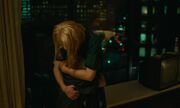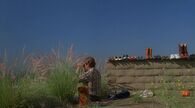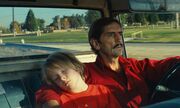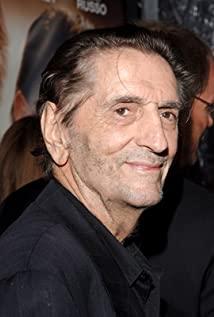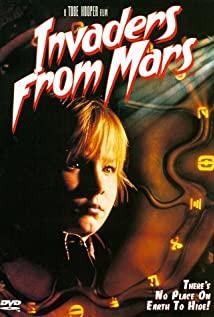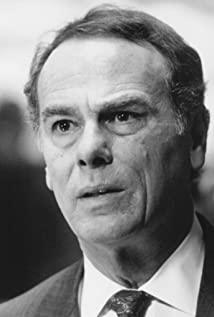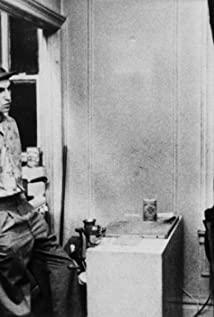In southwestern Texas in the United States, there is a desolate and empty place called "Paris". This is the origin of all the stories in the movie "Paris Texas". The film's protagonist, Travis, a taciturn middle-aged man whose wife has left, traverses the vast desert in search of this place. Travis sees this land as where his mother conceived him, where his life began.
Wenders said the film tells the "story of a man who wanders aimlessly in the desert and returns to civilized life". "Finding" and "Reconciliation" are the two themes of Paris, Texas. The symbolism of "Texas" and "Paris" in the film's title can be considered from at least the following three aspects: first, it represents the value difference between American society and European society; second, the relationship between men and women in modern families Status relations are also introduced symbolically; in addition, "Texas" and "Paris" also express a certain contradictory relationship between the region and the world, the present and the future in the context of modernization.
1. Story and Image: Fear, Banishment, Confession
Shortly after the film begins, Travis doesn't say a word as his brother drives him back to Los Angeles. What happened to him during the four years he was gone, his brother Winter didn't know, and neither did the audience. In Travis' behavior, there is a refusal to communicate emotionally. The younger brother couldn't bear Travis' silence, and just as he was about to break out, he finally began to speak. Travis' first words were: "Paris, Paris, Texas." Travis showed his brother a photo of a place called "Paris" in Texas, USA somewhere in the state. He told his brother that he had bought the place a long time ago.
This scene in the picture has a strong symbolic meaning: "Paris, Texas" is the beginning of Travis's life, and it is also an entrance for him to return to the civilized world from his lonely self. He borrowed a photo (a modern medium) and started trying to communicate with people. After that, he slowly released himself, overcame psychological obstacles little by little, and stepped back into society. Travis has a lot of quirks, like when he refuses to take a plane on the way home, he can't imagine what it's like to leave the ground and fall from the sky. From the relationship between Travis and his younger brother Winter, we find that on the surface, Winter is open and is the link between Travis and the outside world. But it is Travis who dominates between the two, and the younger brother always succumbs to him and keeps trying to enter his world. In fact, in Wenders' films, characters always have one way or another of quirks. They often have problems with their families and even lose contact. They understand their fears and take a consciously or unintentionally self-distancing attitude toward modern society.
"Paris, Texas" is full of Mann's film-specific methods of reconciling the contradictions of the characters. Travis, for example, took the initiative to find a way of communicating that worked for him—using modern media. As shown in Figure 1, the way Travis communicated with his brother was through photographs. When he got home, his way of communicating and reconciling with his son was through video. Together with his younger brother, his wife, and his son, he watched the 8mm family videos they had taken before, recalling the warm scenes from the past. In this scene, the audience sees Travis's wife, a beautiful blonde named "Jane," for the first time on film. The home video brought back memories of the boy saying goodnight to Travis and calling him "Dad." This awakens Travis's "father" identity. But even with the reconciliation, the distance with his son remains. This alienation is personal as well as social, a life situation that someone like Travis will never be able to resolve.
The way Travis and his ex-wife communicated and reconciled was through a single-sided glass phone, which also used modern media. Later in the film, Travis finds Jane and finds her working as a "peep girl" at an adult club. In the club room, male customers can see the "service girl" and the girl can't see him, and they can talk on the phone. This is a rather modern situational setting. The difficulty of communication and understanding and the one-sidedness of the relationship between people are all expressed in the form of film in this unique setting. Travis's conversation with Jane takes place in this context. When he apologized to Jane, he dared not let Jane look at him, and he needed to find a comfortable posture to confess his heart. With his back to Jane, he slowly told about his actions and choices with a confession mentality. This long dialogue (nearly twenty minutes) is the climax of the entire film. In Travis's telling, we as the audience understand what is happening in the story.
Travis' confession is the result of a purgatory he's endured, which echoes the man walking alone in the desert at the beginning, and has some religious overtones. At the start, Travis was caught in a fiery environment, covered in burns. The black eagle of the desert watched him from a bird's-eye view. This scene depicts him falling into purgatory. And at the end of the film, "when he finally meets Jane through the glass, it is actually a confession of guilt. He confesses to the crime of jealousy among the seven deadly sins" ("Wenders' Journey"). When he tried to get Jane to see him, we knew he had overcome another fear in his heart. It is generally considered that Travis' face-to-face with Jane at the end of the credits is a major breakthrough for Wenders. In the previous films, Wenders was better at dealing with the relationship between men, and the character dialogue also pursued a bland life. And in "Paris, Texas," for the first time, he takes a more serious approach to the intensely dramatic dialogue between two opposite sexes.
At the end of the story, Jane meets her son Hunter, who wants to stay and is convinced that he can be accepted, but he cannot forgive himself for his past, so he chooses to leave alone. Wenders explained Travis' departure at the end: "It seems to me that Travis has a fundamental responsibility to Jane and Hunter on this level, that they need each other more than The extent to which he desires to have a family. His greatest responsibility is: release Jane, set her free, so that she can accept the child - he is the only one who can 'save' her. I think if they can be reunited and start a family again, That would be the biggest lie we've ever told." (Ranvaud, "Paris, Texas")
A disengagement out of a sense of responsibility, a liberation of liberty, is a typical Wenders approach.
As a "road movie" director, Wenders is best at banishing characters on a journey, allowing them to find their own direction and ending in life. Before "Paris, Texas," Wenders was best known for his "road movie trilogy" ("Alice in the City," "Broken Road," "King of the Road"), in which, The theme of "searching" is consistent, and the object of the search is a woman, a "mother". The men in the film are eager to find the woman they lost in their lives, because that is the epitome of what their lives lack. The traveler in "Paris, Texas" eventually returns home and makes a kind of reconciliation with his family. And in the first three films, the character always has a dilemma waiting to be solved, forcing him to embark on a journey and keep going.
2. Director's Work: The Textual Power of "Road Movies"
As an "emotionally cold" director, Wenders' personal work style also has a certain randomness. He said of the making of "Paris, Texas," "A lot of my films start with road maps rather than scripts. Sometimes it feels like a flight without a dashboard. You fly overnight and arrive early in the morning. Somewhere. Meaning: You have to try to land somewhere so the movie can wrap up." (Wenders on Cinema)
This quote speaks to two qualities of Wenders' directorial work. First, the way the film is made determines the content of the film. In his films, the story must take place on the journey. Second, the film needs a "dashboard" that guides the way, both in content and form. In fact, in "Paris, Texas," "dashboard" has several meanings that constitute the guiding force of the film's text.
First, the structural tension inherent in the genre of "road movies" has become the most basic guiding force in "Paris, Texas." Unlike "genre films" in American cinema, "road movies" as a subgenre derive their most important plot tension from the uniqueness of their structure. Characters are always on the road, they can have no direction, no goal, but they must have an attitude to life. Where to come from and where to go are the most basic questions that "road movies" preset for characters. "Paris, Texas" combines the philosophical spirit of European directors with American-style characters and scenery to form the story force of "Paris, Texas."
The idea of this film is a bit like the story of the mythical Ulysses. A man travels around with an image of a woman in his head. The film opens with Travis walking through the desert, a scene that sets the tone for the "road movie" of Paris, Texas. All the classic elements of a "road movie" can find their place in this film and serve appropriately to build the story. The endless plains and empty highways, the remote gas station, the street lamps that pass through the windows one by one - the display of the scenery on the road in the film is as important as the story of the characters. The wanton display of the scenery of the American West in the film may not be Wenders' original creation, but under Wenders' lens, the external environment and the characters' hearts form a close relationship and caring relationship. Wenders seeks to create a temporary and fragile relationship between the characters, emphasizing their ambivalence of isolation and mutual needs. For example, after Travis first met his son, he picked him up from school, and they walked side by side across a road. This scene is an effective metaphor for the relationship between father and son at the time: they were strangers to each other because they had not seen each other for four years. But at the same time, their fate is the same, and their common direction is to find that woman - their wife and mother.
Wenders was a big fan of rock and roll, and he wrote reviews for music magazines for a long time. In his films, the rock guitar sound becomes the soundtrack throughout all the works. The soundtrack of "Paris, Texas" is simple: a soothing and restrained guitar solo is played at the right moment when the characters' emotions change, or when the characters are on the road. The desolate guitar sound is in harmony with the American highway scenery, which is both lyrical and narrative, and has become an indispensable and important element in Wen's "road movies". The youth and modernity of the rock spirit also made him different from Antonioni and Ozu.
Another guiding element in "Paris, Texas" is the director's introduction of a unique perspective called "children's vision." Children tend to be the all-seeing, active subject, while adults face all kinds of fears and concerns and are clearly passive. In "Paris, Texas," his son Hunter is at ease no matter where he is, and his unrepressed candor and casual point of view is exactly what Wenders needs in a film. Adults are often vulnerable and blind, and cannot see the essence of things clearly, because adults want too much, worry too much, and are too constrained by society.
There is an episode in the film that seems to reveal the social context of this "children's vision." Travis told Hunt that his own father liked to imagine Hunt's grandmother as a "hip (modern) woman." The old jokes that she was born in "Paris" and paused to say "Texas" made grandmother embarrassed because she wasn't "fashionable" (modern) at all. It can be seen here that Travis' father has a fantasy-like misunderstanding of his mother. We soon found out that Travis had similar false fantasies about his wife, and this became a direct factor in his breakup with Jane. This "father-to-son" moral disease is social, psychological, and unavoidable.
But we do not see the inheritance of this moral ailment in our son Hunter. Just look at their birth years and you'll know why. Travis and his fathers were in a special relationship between post-war America and Europe, and whether in the American environment or in the European environment, people had an illusion about each other that they needed to rebuild the wounded in some way. identity. As a new generation of Hunter, he has been fully integrated into the cultural psychology of globalization. This is also the inner psychological state of German director Wenders shooting American films in the United States.
Wenders' directing style makes his films often reflect the social form of a certain era, and he himself takes this as one of his film artistic goals. For him, feature films are often the best documentaries of a certain era, and his response to the era always begins by showing the lonely hearts of those simple characters. In "King of the Road," two men travel together along the East-West German border, but they are later separated because they know each other too well. In the 1990s, Wenders made another film with world ambitions, Until the End of the World. In order to make this film, the crew traveled more than 20 cities across the world (including Beijing) in more than five months, which is called "the ultimate road film".
3. The location of the film: German films and American films
In 1984, "Paris, Texas" won the Palme d'Or for best film at the 37th Cannes Film Festival, making Wenders the first time he surpassed his previous film circle and became famous in the world, especially for pioneering his career as a director in the United States. Wenders was at a pivotal juncture in his directorial career when he filmed Paris, Texas. On the one hand, he made a series of European-style films (represented by the "Road Trilogy") set in German society in the current trend of the new German film movement. These films focus on the crisis consciousness of a new generation of German men born after World War II. These films initially established him as a director in European cinema. Wenders, on the other hand, had already started working with American studios to create his own world films, but neither achieved significant results.
We can consider the position of "Paris, Texas" in the sequence of Wenders' works from two dimensions. The first dimension is to use "Paris, Texas" as a follow-up work to Wenders' "New German Cinema" movement; the second dimension is to use it as a prelude to Wenders' road to American cinema. As a combination of European films and American films, "Paris, Texas" has a certain vision of world cinema in terms of its production method and content.
Wenders has always admitted his fascination with American culture and American cinema. Especially in the 1930s and 1940s, the "Westerns" represented by Hawks and John Ford films had a deep influence on him. When he was young, Wenders had a mythical longing for the United States, and his first experience of entering the United States to make a film brought him a great cultural shock. “When I was a child, America was an unattainable place, a complete myth, and every time I came to America, it disillusioned me. Once I got there, childhood paradise seemed empty and rotten.” (Wenders On Cinema")
Wenders began his career in American cinema in shock. His first "American film" was "American Friends" in 1977, in which he tried for the first time to put American-style murder stories into his own film format, with plots set in the United States and Europe. Multiple cities are staggered in a vague and mysterious style. After American Friends, Wenders collaborated with famous American director and producer Coppola on a detective novel-altered film, Hammert. Forced to tell stories in a Hollywood-style way, Wenders began to think about the relationship between being a modernist film director and being an American director of storytelling. It was featured in the autobiographical film The State of Things. The State of Things tells the story of a director troubled by a mix of American and European films, exploring the contrasting relationship between European and American cinematic values. It is in this context that the film project for "Paris, Texas" came into operation. While the film isn't officially American (because it's European-funded), Wenders has worked harder in many ways to realize his dream of becoming an American director than he did with Hammert. He worked with typical American screenwriters to create an American story, shooting an American character in an American setting.
"Paris, Texas" gave Wenders his first real success. This success affirms both his heritage of European cinema and his understanding of American cinema. It can be said that "Paris, Texas" made Wenders jump from "European film star" to "world film master". After "Paris, Texas", Wenders has made films with worldwide influence such as "Under the Berlin Sky". In 2009, his new work "Pina" is a documentary filming Pina, the mother of German modern dance, in the form of a 3D film.
View more about Paris, Texas reviews



